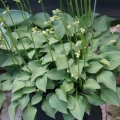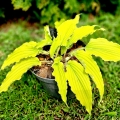Online Shop
128
Royal Horticultural Society
Gold Medals
Royal Horticultural Society
Gold Medals
- Home
- About Ferns
- Fern Care
Fern Care
Try to find a place in the shade for ferns. They ask for very little care, and repay you with ease of growth and breathtaking beauty. Most are easily divided after two or three years in your garden, increasing your plant stock. Best of all, they add texture like no other perennial - graceful and airy, despite their hardiness and willingness to grow. In the wild, ferns thrive in the dappled shade of the woodland, finding their feet in rotted leaves and other rich soil ingredients. Very few can tolerate dry soils, and all prefer a good pampering their first two years - lots of water and humus!
Work the soil well and deep before you plant your fern, raising the bed at least 3 inches above the soil level. If you have heavy soil, lighten it with rotted leaves or coarse bark.
Ferns will thrive with both moisture and excellent drainage and a good, rich mulch works wonders.
Plant your fern very shallowly, with the crown flush with the surrounding soil.
Keep garden debris away from the base of your ferns if you can. Rot can be a problem when the crown of the fern sits in stagnant water, though some, such as the Tatting Fern, will happily rest in an inch or so of water on the bank of a stream or pond. If you see signs of rot, apply a fungicide and the chances are your fern will shake it off.
If possible, water the roots and not the fronds.
If your fern is evergreen, you might want to thin the old fronds in spring as the new ones appear. At the same time, apply a new layer of mulch for the new growing year.
Every 2 or 3 years, you can dig up and divide your fern into several new plants to share with admiring friends or to increase your own garden's beauty!
New Additions
-
Bowdens 2024 Catalogue £0.00

-
Wundergold £15.00

-
venusta 'Porter' £8.00

-
Valley's Love Birds £14.00

-
Valley's Lemon Squash £14.00





